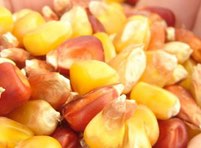The History of GMOs
Learn about the origins of agriculture, the evolution of crop modification and how we got the foods we eat today.
GMO History: Building on Genetic Diversity
 Farmers have intentionally changed the genetic makeup of all the crops they have grown and the livestock they have raised since domestic agriculture began 10,000 years ago. Every fruit, vegetable and grain that is commercially available today has a history of genetic modification by human hands, including organic and heirloom seeds.
Farmers have intentionally changed the genetic makeup of all the crops they have grown and the livestock they have raised since domestic agriculture began 10,000 years ago. Every fruit, vegetable and grain that is commercially available today has a history of genetic modification by human hands, including organic and heirloom seeds.
In the late 20th century, advances in technology have enabled us to expand the genetic diversity of crops. For years, university, government, and company scientists intensively researched and refined this process. A major result has been GM seeds that maintain or increase the yield of crops while requiring less land and fewer inputs, both of which lessen the impact of agriculture on the environment and reduce costs for farmers.
See how crops have evolved from ancient Egypt until today in this infographic from European Biotech Week, and then journey through the last 80 years of modern agriculture with Crop Life America.
GM Corn: Genetically Modified Corn History
 Over the past century, corn has evolved with the availability of hybrid corn in the 1930s and the planting of GM crops in the mid-1990s. Due to the insect resistance and/or herbicide tolerance of GM corn, more and more of it was planted. Contrary to popular belief, the physical appearance of corn before GMO – or corn before selective breeding – is the same as corn after GMO. Its appearance has not changed with the development and increased usage of GM corn.
Over the past century, corn has evolved with the availability of hybrid corn in the 1930s and the planting of GM crops in the mid-1990s. Due to the insect resistance and/or herbicide tolerance of GM corn, more and more of it was planted. Contrary to popular belief, the physical appearance of corn before GMO – or corn before selective breeding – is the same as corn after GMO. Its appearance has not changed with the development and increased usage of GM corn.
What has changed, due to modern plant breeding, is the corn’s size, consistency, seed performance, yield, the number of ears per stalk and the position of the ear and the leaves on the stalk. Currently, a plant has only one ear located about waist high (the height of a combined blade), and its leaves grow at a more upright angle to better catch sun rays and rain. A century ago, farmers planted about 8,000 corn plants per acre. Today they plant about four times as many plants per acre.
The History of GMO Crops
 10,000 Years Ago: Humans begin crop domestication using selective breeding.
10,000 Years Ago: Humans begin crop domestication using selective breeding.
1700s: Farmers and scientists begin cross-breeding plants within a species.
1940s and 1950s: Breeders and researchers seek out additional means to introduce genetic variation into the gene pool of plants.
1980s: Researchers develop the more precise and controllable methods of genetic engineering to create plants with desirable traits.
1990s: The first GMOs are introduced into the marketplace.
When Were GMOs Introduced?
1995: Soy Beans
1995: Squash
1996: Corn
1996: Cotton
1997: Papaya
1999: Canola
2006: Alfalfa
2006: Sugar Beets
2013: Eggplant (Bangladesh only)
2016: Potatoes
2017: Apples
2018: Sugar Cane (Brazil)
2020: Pink Pineapple
To better understand why GMOs were initially created and the evolution of crop modification we encourage you to read more here.